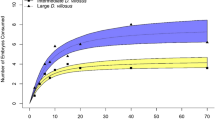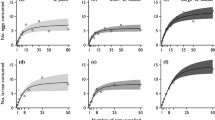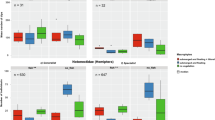Abstract
Habitat permanence and threat of predation are primary drivers of community assembly and composition in lentic freshwater systems. Pond-breeding amphibians select oviposition sites to maximize fitness and minimize risks of predation and desiccation of their offspring, typically facing a trade-off between the two as predation risk often increases as desiccation risk decreases. To experimentally determine if Hyla chrysoscelis partition oviposition along gradients of relative desiccation risk and predation risk, we tested oviposition site preference in a natural population of treefrogs colonizing experimental ponds that varied in water depth and contained predatory larvae of two Ambystoma salamander species. Hyla chrysoscelis selected habitats with both lower predation risk, avoiding A. talpoideum over A. maculatum, and lower desiccation risk, selecting ponds with three times greater depth. We demonstrate that adult oviposition site choices simultaneously minimize relative predation risk and desiccation risk and that closely related salamander species produce functionally different responses among colonizing animals.


Similar content being viewed by others
References
Altig R, McDiarmid RW (2015) Handbook of larval amphibians of the United States and Canada. Cornell University Press, Ithaca
Anderson TL, Mott CL, Levine TD, Whiteman HH (2013) Life cycle complexity influences intraguild predation and cannibalism in pond communities. Copeia 2013:284–291. doi:10.1643/CE-12-034
Binckley CA, Resetarits WJ Jr (2003) Functional equivalence of non-lethal effects: generalized fish avoidance determines distribution of gray treefrog, Hyla chrysoscelis, larvae. Oikos 102:623–629. doi:10.1034/j.1600-0706.2003.12483.x
Binckley CA, Resetarits WJ Jr (2008) Oviposition behavior partitions aquatic landscapes along predation and nutrient gradients. Behav Ecol 19:552–557. doi:10.1093/beheco/arm164
Blaustein L, Kotler BP, Ward D (1995) Direct and indirect effects of a predatory backswimmer (Notonecta maculata) on community structure of desert temporary pools. Ecol Entomol 20:311–318. doi:10.1111/j.1365-2311.1995.tb00462.x
Blaustein L, Kiflawi M, Eitam A et al (2004) Oviposition habitat selection in response to risk of predation in temporary pools: mode of detection and consistency across experimental venue. Oecologia 138:300–305. doi:10.1007/s00442-003-1398-x
Both C, Bouwhuis S, Lessells CM, Visser ME (2006) Climate change and population declines in a long-distance migratory bird. Nature 441:81–83. doi:10.1038/nature04539
Carpenter SR, Kitchell JF, Hodgson JR (1985) Cascading trophic interactions and lake productivity. Bioscience 35:634–639. doi:10.2307/1309989
DeWitt TJ, Robinson BW, Wilson DS (2000) Functional diversity among predators of a freshwater snail imposes an adaptive trade-off for shell morphology. Evol Ecol Res 2:129–148
Grabowski JH, Hughes AR, Kimbro DL (2008) Habitat complexity influences cascading effects of multiple predators. Ecology 89:3413–3422. doi:10.1890/07-1057.1
Gripenberg S, Mayhew PJ, Parnell M, Roslin T (2010) A meta-analysis of preference-performance relationships in phytophagous insects. Ecol Lett 13:383–393. doi:10.1111/j.1461-0248.2009.01433.x
Jackson DA, Peres-Neto PR, Olden JD (2001) What controls who is where in freshwater fish communities—the roles of biotic, abiotic, and spatial factors. Can J Fish Aquat Sci 58:157–170. doi:10.1139/f00-239
Jaenike J (1978) On optimal oviposition behavior in phytophagous insects. Theor Popul Biol 14:350–356. doi:10.1016/0040-5809(78)90012-6
Kats LB, Sih A (1992) Oviposition site selection and avoidance of fish by streamside salamanders (Ambystoma barbouri). Copeia 1992:468–473. doi:10.2307/1446206
Kiflawi M, Blaustein L, Mangel M (2003) Oviposition habitat selection by the mosquito Culiseta longiareolata in response to risk of predation and conspecific larval density. Ecol Entomol 28:168–173. doi:10.1046/j.1365-2311.2003.00505.x
Kraus JM, Vonesh JR (2010) Feedbacks between community assembly and habitat selection shape variation in local colonization. J Anim Ecol 79:795–802. doi:10.1111/j.1365-2656.2010.01684.x
Martin TE (2001) Abiotic vs. biotic influences on habitat selection of coexisting species: climate change impacts? Ecology 82:175–188. doi:10.1890/0012-9658(2001)082[0175:AVBIOH]2.0.CO;2
McGuffin MA, Baker RL, Forbes MR (2006) Detection and avoidance of fish predators by adult Enallagma damselflies. J Insect Behav 19:77–91. doi:10.1007/s10905-005-9013-0
Menge BA, Sutherland JP (1987) Community regulation: variation in disturbance, competition, and predation in relation to environmental stress and recruitment. Am Nat 130:730–757. doi:10.1086/284741
Messina FJ, Kemp JL, Dickinson JA (1992) Plasticity in the egg-spacing behavior of a seed beetle: effects of host deprivation and seed patchiness (Coleoptera: Bruchidae). J Insect Behav 5:609–621. doi:10.1007/BF01048008
Morin PJ, Lawler SP, Johnson EA (1988) Competition between aquatic insects and vertebrates: interaction strength and higher order interactions. Ecology 69:1401–1409. doi:10.2307/1941637
Paine RT (1966) Food web complexity and species diversity. Am Nat 100:65–75
Petranka JW (1998) Salamanders of the United States and Canada. Smithsonian Institution Press, Washington, DC
Petranka JW, Kats LB, Sih A (1987) Predator-prey interactions among fish and larval amphibians: use of chemical cues to detect predatory fish. Anim Behav 35:420–425. doi:10.1016/S0003-3472(87)80266-X
Pintar MR, Resetarits WJ Jr (2017a) Out with the old, in with the new: oviposition preference matches larval success in Cope’s gray treefrog, Hyla chrysoscelis. J Herpetol 51:186–189. doi:10.1670/16-019
Pintar MR, Resetarits WJ Jr (2017b) Data for “Relative predation risk and risk of desiccation co-determine oviposition preferences in Cope’s gray treefrog, Hyla chrysoscelis”. Figshare. doi:10.6084/m9.figshare.4887020
R Core Team (2016) R: a language and environment for statistical computing. R Foundation for Statistical Computing, Vienna
Resetarits WJ Jr (2001) Colonization under threat of predation: avoidance of fish by an aquatic beetle, Tropisternus lateralis (Coleoptera: Hydrophilidae). Oecologia 129:155–160. doi:10.1007/S004420100704
Resetarits WJ Jr (2005) Habitat selection behaviour links local and regional scales in aquatic systems. Ecol Lett 8:480–486. doi:10.1111/j.1461-0248.2005.00747.x
Resetarits WJ Jr, Binckley CA (2009) Spatial contagion of predation risk affects colonization dynamics in experimental aquatic landscapes. Ecology 90:869–876. doi:10.1890/08-0613.1
Resetarits WJ Jr, Binckley CA (2013) Is the pirate really a ghost? Evidence for generalized chemical camouflage in an aquatic predator, pirate perch Aphredoderus sayanus. Am Nat 181:690–699. doi:10.1086/670016
Resetarits WJ Jr, Chalcraft DR (2007) Functional diversity within a morphologically conservative genus of predators: implications for functional equivalence and redundancy in ecological communities. Funct Ecol 21:793–804. doi:10.1111/j.1365-2435.2007.01282.x
Resetarits WJ Jr, Pintar MR (2016) Functional diversity of non-lethal effects, chemical camouflage, and variation in fish avoidance in colonizing beetles. Ecology 97:3517–3529. doi:10.1002/ecy.1593
Resetarits WJ Jr, Wilbur HM (1989) Choice of oviposition site by Hyla chrysoscelis: role of predators and competitors. Ecology 70:220–228. doi:10.2307/1938428
Resetarits WJ Jr, Wilbur HM (1991) Calling site choice by Hyla chrysoscelis: effect of predators, competitors, and oviposition sites. Ecology 72:778–786. doi:10.2307/1940580
Rieger JF, Binckley CA, Resetarits WJ Jr (2004) Larval performance and oviposition site preference along a predation gradient. Ecology 85:2094–2099. doi:10.1890/04-0156
Rudolf VHW, Rödel M-O (2005) Oviposition site selection in a complex and variable environment: the role of habitat quality and conspecific cues. Oecologia 142:316–325. doi:10.1007/s00442-004-1668-2
Růžička Z (2001) Oviposition responses of aphidophagous coccinellids to tracks of ladybird (Coleoptera: Coccinellidae) and lacewing (Neuroptera: Chrysopidae) larvae. Eur J Entomol 98:183–188. doi:10.14411/eje.2001.034
Saward-Arav D, Sadeh A, Mangel M et al (2016) Oviposition responses of two mosquito species to pool size and predator presence: varying trade-offs between desiccation and predation risks. Isr J Ecol Evol. doi:10.1080/15659801.2015.1069113
Schmitz OJ (2009) Effects of predator functional diversity on grassland ecosystem function. Ecology 90:2339–2345. doi:10.1890/08-1919.1
Schmitz OJ, Sokol-Hessner L (2002) Linearity in the aggregate effects of multiple predators in a food web. Ecol Lett 5:168–172. doi:10.1046/j.1461-0248.2002.00311.x
Schneider DW, Frost TM (1996) Habitat duration and community structure in temporary ponds. J N Am Benthol Soc 15:64–86. doi:10.2307/1467433
Scott GR, Sloman KA (2004) The effects of environmental pollutants on complex fish behaviour: integrating behavioural and physiological indicators of toxicity. Aquat Toxicol 68:369–392. doi:10.1016/j.aquatox.2004.03.016
Segev O, Mangel M, Wolf N et al (2011) Spatiotemporal reproductive strategies in the fire salamander: a model and empirical test. Behav Ecol 22:670–678. doi:10.1093/beheco/arr029
Sih A, Englund G, Wooster D (1998) Emergent impacts of multiple predators on prey. Trends Ecol Evol 13:350–355. doi:10.1016/S0169-5347(98)01437-2
Silberbush A, Blaustein L (2011) Mosquito females quantify risk of predation to their progeny when selecting an oviposition site. Funct Ecol 25:1091–1095. doi:10.1111/j.1365-2435.2011.01873.x
Skelly DK (1996) Pond drying, predators, and the distribution of Pseudacris tadpoles. Copeia 3:599–605. doi:10.2307/1447523
Spencer M, Blaustein L (2001) Hatching responses of temporary pool invertebrates to signals of environmental quality. Isr J Zool 47:397–418. doi:10.1560/23F2-2XBW-252B-DU5C
Thompson JN, Pellmyr O (1991) Evolution of oviposition behavoir and host preference in Lepidoptera. Annu Rev Entomol 36:65–89. doi:10.1146/annurev.en.36.010191.000433
Touchon JC, Warkentin KM (2008) Reproductive mode plasticity: aquatic and terrestrial oviposition in a treefrog. Proc Natl Acad Sci 105:7495–7499. doi:10.1073/pnas.0711579105
Touchon JC, Warkentin KM (2009) Negative synergism of rainfall patterns and predators affects frog egg survival. J Anim Ecol 78:715–723. doi:10.1111/j.1365-2656.2009.01548.x
Tumlison R, Serviss B (2013) Novel Food habits of branchiate mole salamanders (Ambystoma talpoideum) from Southwestern Arkansas. Southeast Nat 12:579–588. doi:10.1656/058.012.0312
Vonesh JR, Blaustein L (2010) Predator-induced shifts in mosquito oviposition site selection: a meta-analysis and implications for vector control. Isr J Ecol Evol 56:263–279. doi:10.1560/IJEE.56.3-4.263
Vonesh JR, Kraus JM, Rosenberg JS, Chase JM (2009) Predator effects on aquatic community assembly: disentangling the roles of habitat selection and post-colonization processes. Oikos 118:1219–1229. doi:10.1111/j.1600-0706.2009.17369.x
Walls SC (1996) Differences in foraging behaviour explain interspecific growth inhibition in competing salamanders. Anim Behav 52:1157–1162. doi:10.1006/anbe.1996.0262
Walters B (1975) Studies of interspecific predation within an amphibian community. J Herpetol 9:267–279. doi:10.2307/1563191
Wellborn GA, Skelly DK, Werner EE (1996) Mechanisms creating community structure across a freshwater habitat gradient. Annu Rev Ecol Syst 27:337–363. doi:10.1146/annurev.ecolsys.27.1.337
Wilbur HM (1997) Experimental ecology of food webs: complex systems in temporary ponds. Ecology 78:2279–2302. doi:10.1890/0012-9658(1997)078[2279:EEOFWC]2.0.CO;2
Wilbur HM, Alford RA (1985) Priority effects in experimental pond communities: responses of Hyla to Bufo and Rana. Ecology 66:1106–1114. doi:10.2307/1939162
Wilbur HM, Collins JP (1973) Ecological aspects of amphibian metamorphosis. Science 182:1305–1314. doi:10.1126/science.182.4119.1305
Woodward BD (1983) Predator-prey interactions and breeding-pond use of temporary-pond species in a desert anuran community. Ecology 64:1549–1555. doi:10.2307/1937509
Acknowledgements
J. Bohenek and L. Eveland assisted with fieldwork. T. Breech provided helpful comments on the manuscript. Support was provided by the University of Mississippi and the Henry L. and Grace Doherty Foundation. This research was approved by the University of Mississippi’s Institutional Animal Care and Use Committee (14-027) and the Mississippi Department of Wildlife, Fisheries, and Parks (0624141). The authors declare no conflicts of interest.
Author information
Authors and Affiliations
Contributions
MRP conceived, designed, and conducted the experiment. MRP analyzed the data and wrote the manuscript with input from WJR. Both authors gave final approval for publication.
Corresponding author
Additional information
Communicated by Howard Whiteman.
Rights and permissions
About this article
Cite this article
Pintar, M.R., Resetarits, W.J. Relative predation risk and risk of desiccation co-determine oviposition preferences in Cope’s gray treefrog, Hyla chrysoscelis . Oecologia 184, 423–430 (2017). https://doi.org/10.1007/s00442-017-3875-7
Received:
Accepted:
Published:
Issue Date:
DOI: https://doi.org/10.1007/s00442-017-3875-7




